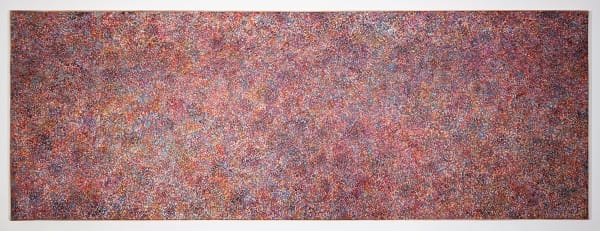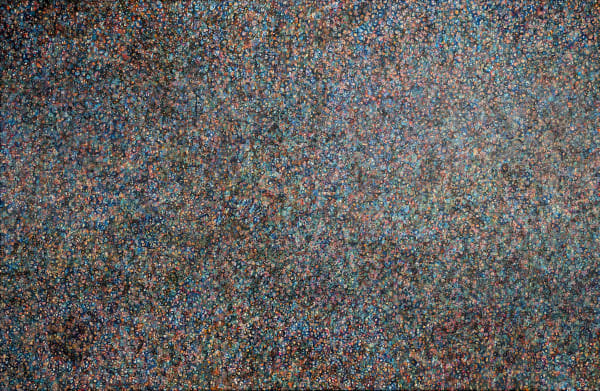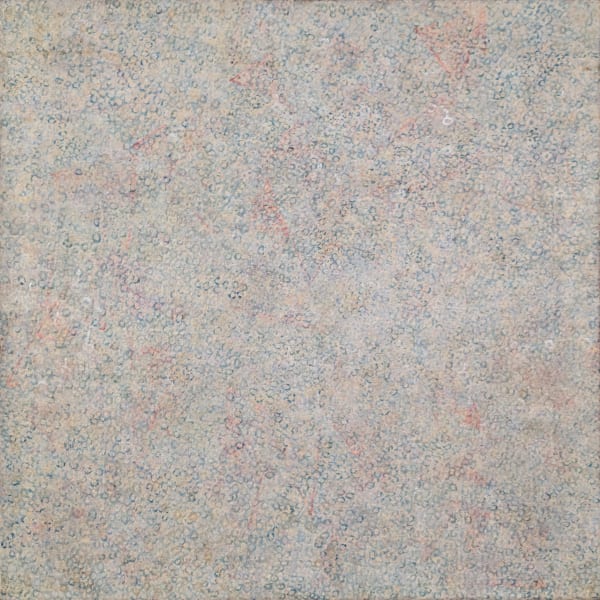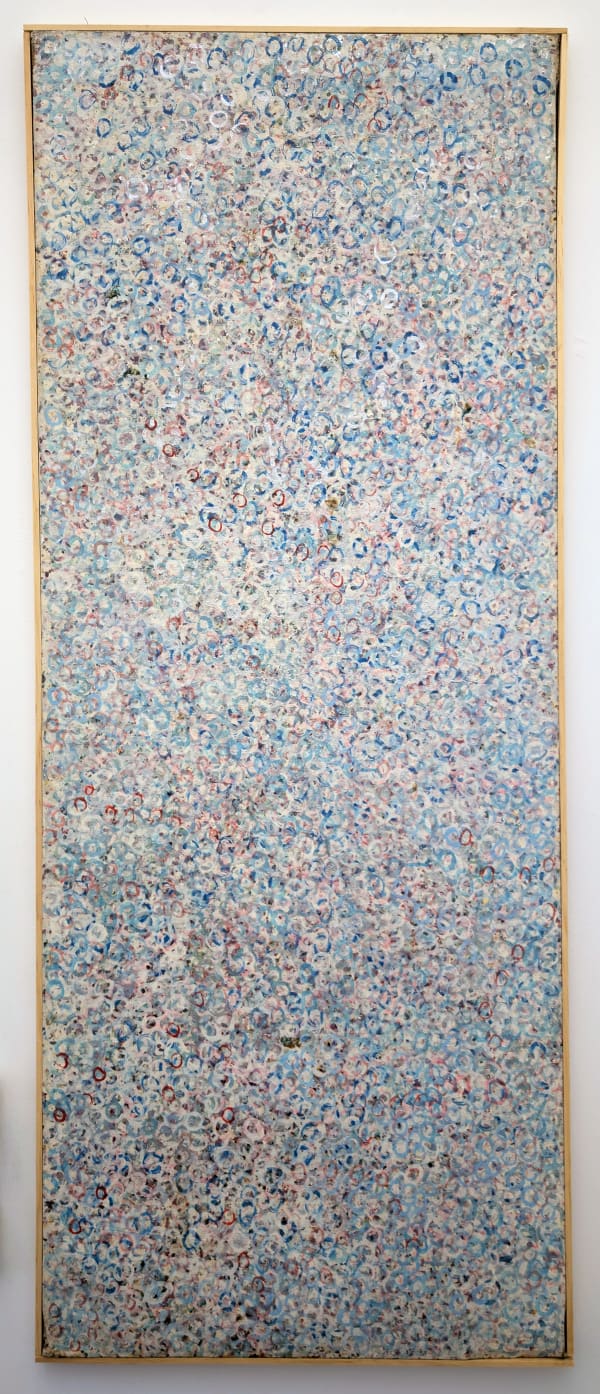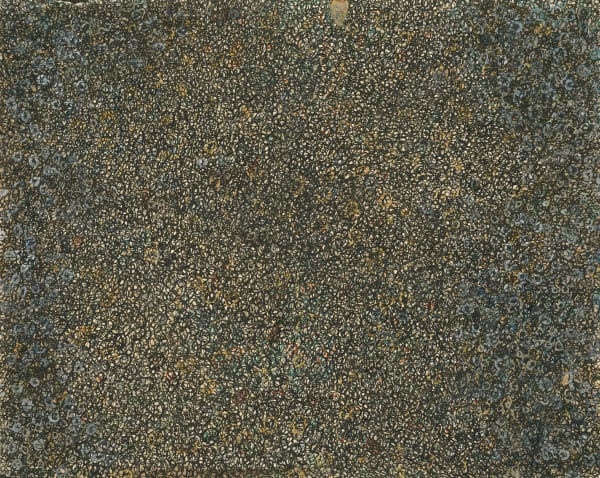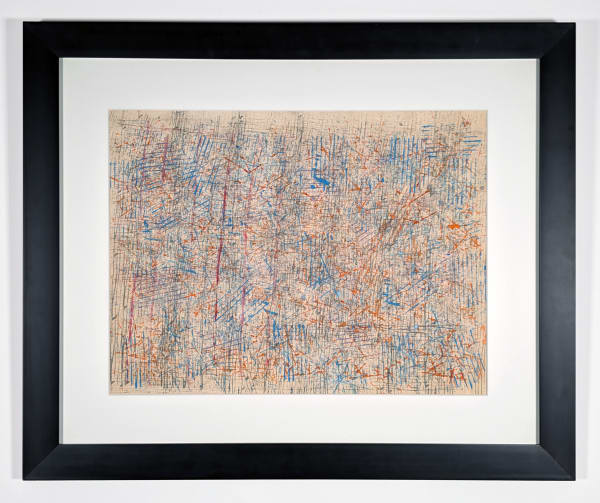Mark Makers: Inger Johanne Grytting and James Juthstrom
WESTWOOD GALLERY NYC presents Mark Makers, an exhibition of paintings and works on paper by Inger Johanne Grytting (b. 1949) and James Juthstrom (1925-2007), two New York-based artists of Nordic heritage engaged in the practice of mark-making.
Mark-making is an artistic practice defined by its indexical relationship to energy and movement and is best characterized by its intuitive, impulsive rhythm. Unbounded by the limitations imposed by representation, both artists use repetitive gestural marks to express personal truths stemming from intuition and impulse.
Mark Makers showcases twelve post-minimal drawings and paintings by Grytting alongside nine paintings and works on paper by Juthstrom, together demonstrating how vulnerability and truth may emerge at the intersection of intentionality and intuition.
The exhibition, curated by James Cavello, is on view November 7, 2024 – January 18, 2025.
-
 Inger Johanne Grytting, M 8, 2020
Inger Johanne Grytting, M 8, 2020 -
 Inger Johanne Grytting, T 2, 2024
Inger Johanne Grytting, T 2, 2024 -
 Inger Johanne Grytting, T 4, 2024
Inger Johanne Grytting, T 4, 2024 -
 Inger Johanne Grytting, T 4, 2020
Inger Johanne Grytting, T 4, 2020
-
 Inger Johanne Grytting, T 14, 2020
Inger Johanne Grytting, T 14, 2020 -
 Inger Johanne Grytting, T 14, 2017
Inger Johanne Grytting, T 14, 2017 -
 Inger Johanne Grytting, T 9, 2016
Inger Johanne Grytting, T 9, 2016 -
 Inger Johanne Grytting, T 3B, 2015
Inger Johanne Grytting, T 3B, 2015
-
 Inger Johanne Grytting, T 5, 2015
Inger Johanne Grytting, T 5, 2015 -
 Inger Johanne Grytting, T 19, 2015
Inger Johanne Grytting, T 19, 2015 -
 James Juthstrom, Untitled #090, circa 1980s
James Juthstrom, Untitled #090, circa 1980s -
 James Juthstrom, Untitled #651, circa 1980s
James Juthstrom, Untitled #651, circa 1980s
-
 James Juthstrom, Untitled #105, circa 1980s
James Juthstrom, Untitled #105, circa 1980s -
 James Juthstrom, Universal #2, circa 1980s
James Juthstrom, Universal #2, circa 1980s -
 James Juthstrom, Untitled #330, circa 1980s
James Juthstrom, Untitled #330, circa 1980s -
 James Juthstrom, Untitled #063, circa 1980s
James Juthstrom, Untitled #063, circa 1980s
-
 Mark Makers: Inger Johanne Grytting and James Juthstrom | Installation View
Mark Makers: Inger Johanne Grytting and James Juthstrom | Installation View -
 Mark Makers: Inger Johanne Grytting and James Juthstrom | Installation View
Mark Makers: Inger Johanne Grytting and James Juthstrom | Installation View -
 Mark Makers: Inger Johanne Grytting and James Juthstrom | Installation View
Mark Makers: Inger Johanne Grytting and James Juthstrom | Installation View -
 Mark Makers: Inger Johanne Grytting and James Juthstrom | Installation View
Mark Makers: Inger Johanne Grytting and James Juthstrom | Installation View -
 Mark Makers: Inger Johanne Grytting and James Juthstrom | Installation View
Mark Makers: Inger Johanne Grytting and James Juthstrom | Installation View -
 Mark Makers: Inger Johanne Grytting and James Juthstrom | Installation View
Mark Makers: Inger Johanne Grytting and James Juthstrom | Installation View -
 Mark Makers: Inger Johanne Grytting and James Juthstrom | Installation View
Mark Makers: Inger Johanne Grytting and James Juthstrom | Installation View -
 Mark Makers: Inger Johanne Grytting and James Juthstrom | Installation View
Mark Makers: Inger Johanne Grytting and James Juthstrom | Installation View -
 Mark Makers: Inger Johanne Grytting and James Juthstrom | Installation View
Mark Makers: Inger Johanne Grytting and James Juthstrom | Installation View -
 Mark Makers: Inger Johanne Grytting and James Juthstrom | Installation View
Mark Makers: Inger Johanne Grytting and James Juthstrom | Installation View -
 Mark Makers: Inger Johanne Grytting and James Juthstrom | Installation View
Mark Makers: Inger Johanne Grytting and James Juthstrom | Installation View -
 Mark Makers: Inger Johanne Grytting and James Juthstrom | Installation View
Mark Makers: Inger Johanne Grytting and James Juthstrom | Installation View -
 Mark Makers: Inger Johanne Grytting and James Juthstrom | Installation View
Mark Makers: Inger Johanne Grytting and James Juthstrom | Installation View -
 Mark Makers: Inger Johanne Grytting and James Juthstrom | Installation View
Mark Makers: Inger Johanne Grytting and James Juthstrom | Installation View -
 Mark Makers: Inger Johanne Grytting and James Juthstrom | Installation View
Mark Makers: Inger Johanne Grytting and James Juthstrom | Installation View -
 Mark Makers: Inger Johanne Grytting and James Juthstrom | Installation View
Mark Makers: Inger Johanne Grytting and James Juthstrom | Installation View -
 Mark Makers: Inger Johanne Grytting and James Juthstrom | Installation View
Mark Makers: Inger Johanne Grytting and James Juthstrom | Installation View -
 Mark Makers: Inger Johanne Grytting and James Juthstrom | Installation View
Mark Makers: Inger Johanne Grytting and James Juthstrom | Installation View -
 Mark Makers: Inger Johanne Grytting and James Juthstrom | Installation View
Mark Makers: Inger Johanne Grytting and James Juthstrom | Installation View -
 Mark Makers: Inger Johanne Grytting and James Juthstrom | Installation View
Mark Makers: Inger Johanne Grytting and James Juthstrom | Installation View -
 Mark Makers: Inger Johanne Grytting and James Juthstrom | Installation View
Mark Makers: Inger Johanne Grytting and James Juthstrom | Installation View
WESTWOOD GALLERY NYC presents Mark Makers, an exhibition of paintings and works on paper by Inger Johanne Grytting (b. 1949) and James Juthstrom (1925-2007), two New York-based artists of Nordic heritage engaged in the practice of mark-making. Unbounded by the limitations imposed by representation, both artists use repetitive gestural marks to express personal truths stemming from intuition and impulse. The exhibition is curated by James Cavello and will be on view November 7, 2024 – January 18, 2025.
Mark-making is an artistic practice defined by its indexical relationship to energy and movement and is best characterized by its intuitive, impulsive rhythm. Experiencing these abstract works is like seeing handwriting in a diary and directly sensing the deep personal energy communicated through the artists’ gestures. Mark Makers showcases artworks balanced between the unconscious and the intentional, revealing true and vulnerable portraits of these two artists.
Inger Johanne Grytting’s twelve post-minimal drawings and paintings on view display affinities with both Minimalism and Abstract Expressionism, although neither genre properly encapsulates her method or practice. Rather, the artist describes her process as “a probing inwards” through which “emotions and insights are translated into graphic expressions.”
Her line drawings, such as T 14 (2020) and T 4 (2020), reflect Minimalist influences and her interest in the grid-like abstractions of artists such as Agnes Martin or Robert Ryman. The repetition of simple forms and underlying geometric structures conveys principles of anonymity and restraint characteristic of Minimalist practices of the 1960s. However, it is precisely the strictness of her methods that makes each expressive variation more apparent. Grytting underscores the spontaneity in her drawings by leaving a small gap in her lines when her pencil tip breaks–creating tiny pauses in a concentrated sea of graphite lines. The emphasis created by these breaks imbues her drawings with a rhythmic tempo–each line becoming a record of time and mental space.
James Juthstrom similarly fills his hypnotic artworks with a sense of his own energy and presence. The paintings and works on paper on view were created during a period between the late 1970s and 80s when the artist was consumed by the practice of mark-making. Working out of his Broome Street loft, Juthstrom dedicated months–sometimes years–to building layer upon layer of shimmering pigments, cryptic patterns, hatch marks, and small rings. These rings, created with Q-tips in lieu of brushes, were the result of years of experimentation with various unconventional tools to create the “perfect hand-painted circle.”
Working in New York throughout the mid-century, Juthstrom was certainly influenced by the tenets of Abstract Expressionism. Reminiscent of Rothko’s color field paintings or Pousette-Dart’s cosmological canvases, Juthstrom’s ethereal Untitled #651 (c. 1980s) conveys a moodiness in its depth and subtle nuances of hue. However, Juthstrom’s idiosyncratic and impulsive mark-making technique underscores a uniquely human quality in his artwork. The presence of the artist’s distinct personal energy becomes particularly salient in his smaller untitled drawings on view, revealing both a kinetic and emotional energy emanating from the raw and emphatic gestures. In their seemingly infinite iterations, each circle attests to the artist’s dedication to his vision. Through his mark-making, Juthstrom also offers us “a probing inwards” –a glimpse into his mind and intuition.
While both artists operated within proximity of established art movements and contemporary styles, their bodies of work are unmistakably their own. Their artworks offer insight into the artists’ methods and practices, and act as visual records of the moments, memories, and feelings we can retrace in perpetuity.
______________________________________
Inger Johanne Grytting (b. 1949) was born and raised in Svolvær, Norway, a small island town on the Lofoten archipelago. In 1972, Grytting moved to the Bowery in New York City, where she studied art at The City College of New York. She was guided by her friend and mentor Jan Groth (1938-2022) who introduced her to the New York art scene. In addition to her art practice, Grytting was the art director of Fiction Magazine for over forty years, where she connected international writers and visual artists. Grytting’s artwork is exhibited internationally and collected by museums and private collections. Selected museum exhibitions include The Vigeland Museum (Oslo, Norway), and Nordnorsk Kunstmuseum (Tromsø, Norway). Her artworks are in the collection of The National Museum of Art (Oslo, Norway), Stavanger Kunstmuseum (Stavanger, Norway), Nordnorsk Kunstmuseum (Tromsø, Norway), KODE (Bergen, Norway), and others. Grytting will be the subject of a forthcoming retrospective exhibition at the Tegnerforbundet in Oslo in 2025.
James Juthstrom (1925-2007) was an American artist who was born in the Bronx to a Finnish immigrant family. James Juthstrom studied at the Brooklyn Museum Art School under Bill Kienbusch (Modernist painter, 1914-1980) and Reuben Tam (American Landscape painter, 1916-1991). Following his initial success in the 1950s, he traveled around the country, visiting the Hawaiian Islands, the mountains of Southern California, and the highlands of the Southeast. When he returned to New York in 1965, he leased the top floor of an abandoned, burnt out brownstone loft building in SoHo on Broome Street, where he lived and worked for 50 years creating paintings, drawings, etchings, and sculpture ranging from abstract to figurative. His artwork was exhibited at the Brooklyn Museum (1955, 1956, 1958, 1960), the Whitney Museum of American Art (1956), Detroit Institute of Arts (1957), Gallery G (1957), Pennsylvania Academy of Fine Arts (1959, 1960, 1963, 1967), and The Bronx Museum (1977), among others. Although he had opportunities for gallery representation, he lived on an electrician’s salary and was driven purely by an instinctive drive towards self-expression, creating work in the privacy of his loft.
Inger Johanne Grytting and the Estate of James Juthstrom are represented exclusively by Westwood Gallery NYC.











